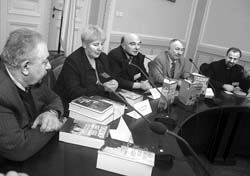Ukrainian-minded books
A novelty of “<I>The Day</I>’s Library” series was introduced at the 14th Forum of Publishers in Lviv
Yurii Logush, a well-known international company’s chairman, called to the editorial office one day and asked to find our newspaper’s issue containing the continuation of the material written by Stanislav Kulchytsky and entitled “Why did Stalin annihilate us?” It occurred that he was collecting all publications of his author’s cycle. (It is a steadfast tendency. Many respected Ukrainian historians, philosophers, literature critics and linguists confessed that they had whole piles of The Day’s press cuttings, until they were incorporated into the books Ukraine Incognita, Dvi Rusi, Wars and Peace, Day and Eternity of James Mace, Apocryfy of Klara Gudzyk, and My Universities from our newspaper’s library.) Obviously, a same thing is happening this time. In the first numbers of September, the book by Stanislav Kulchytsky Why did He Annihilate Us?/ Stalin and the Ukrainian Holodomor, based on The Day’s publications (2005-2007), was published. It contains valuable photos from engineer Vinerberger’ collection and from the collection Famine in the Soviet Ukraine 1932-33, published at the Harvard University in 1986 using the resources of the Central State Archives of the Cinematic-Photographic Documents of Ukraine. The foreword was written by Editor in Chief Larysa Ivshyna, and the book was published under her overall editorship. The afterword was written by Director of Ukrainian Sciences Department at the Rome University “La Sapienza”, writer Oksana Pakhliovska. The presentation of the book by Stanislav Kulchytsky Why did He Annihilate Us/Stalin and the Ukrainian Holodomor took place within the framework of the 14th Forum of Publishers in Lviv. A roundtable “Holodomor in Ukraine 1932-33. Document Heritage” was held in the Mirror Hall at the Lviv-based Ivan Franko National University. Novelette Holodomor in Ukraine 1932-33: Documents and Materials was introduced too (Kyiv Mohyla Academy Publishing House). It was compiled by Ruslan Pyrih.
“I have been studying this topic practically since 2004,” Stanislav Kulchytsky explains, “although I have been studying the Holodomor probably since 1985. The thing is that today the question of the Holodomor as an act of genocide has been broached, therefore, one has to reinterpret everything in the view of this. Actually, the new book of “ The Day’s Library” is revealing the topic of the Holodomor as an and act of genocide. Clearly, the famine of 1932-33 was an all- union one, however, it was much worse on the Ukrainian territory than anywhere else. Everywhere the famine was caused by grain- collections. But Ukrainians faced something else — not grain-collection, but a punitive action of confiscation of all means for living. Since one could not buy food anywhere else (a rationing system was implemented,) peasants started to day in masses (they did not receive the ration cards.) What was the reason for this? In order to feed the peasants afterwards. Thus, the state first had confiscated everything, and afterwards started to feed them, so to say, from hands. Obviously, not all were fed, for millions died. This was a lesson taught by Stalin to the Ukrainian peasants that were not eager to work for the state for nothing, because everything they collected had been confiscated for three years. However, Stalin also learnt a lesson. Starting from 1933, the base of coexistence of collective farms and state economy were built in another way: it was based on taxes. This meant that the state had recognized that produced good remained within the ownership of peasants and collective farms, therefore, this was no slave work, but that of a serf.” Stanislav Vladyslavovych responded in a laconic to the question, why the book was published in Russian, “The purpose was to make people living in the east and south of Ukraine in particular, and also in the Post-Soviet area, read the book, “
Head of the Radio and Television Department at the Lviv- based Ivan Franko National University Vasyl Lyzanchuk asked, in which way the scholar’s evolution develops in the view of such a dramatic theme. “A well-known American Scientist James Mace, who studied the Ukrainian Holodomor, published the article How Ukraine was Allowed to Believe in a foreign magazine in 1994,” Kulchytsky said, “The article consisted of nine chapters, one of them devoted to me. I must say that at first there was a misunderstanding between me and James, but afterwards we have reached a consensus. For he wrote that Kulchytsky was a soviet professor at first, and became simply a professor after starting to study the Holodomor.”
In his turn, Head of the Ukrainian Revolution Department at the Institute of the History of Ukraine of the NAN of Ukraine, compiler of The Holodomor in Ukraine 1932-33: Documents and Materials Ruslan Pyrih explained that in 2003 the archives of the Russian President transferred the Political Bureau materials that have never been published previously to the Russian State Archives of the social-political history. “It was resolved that I would take this project,” the scholar went on. “The collection is a synthetic one. The Russian study of early texts have published many similar projects like Tragedy of Soviet Village or Lubianka for Stalin. Ukraine has few of these books. Therefore their most interesting documents and too the documents from the Political Bureau, foreign intelligence services and Stalin, Molotov and Kahanovych’s correspondence have been included to my book. The materials and documents from the total of 15 Ukrainian central and oblast archives and five RF archives were included into the collection.”
The associate worker of the State SBU branch archives, historian Dr. Vasyl Danylenko, who took part in publication of Declassified Memory, said that both books, Why Did He Annihilate Us and Holodomor in Ukraine 1932-33: Documents Materials, belong to the decade’s best ones for their significance.






